Artist Odilon Redon | ||
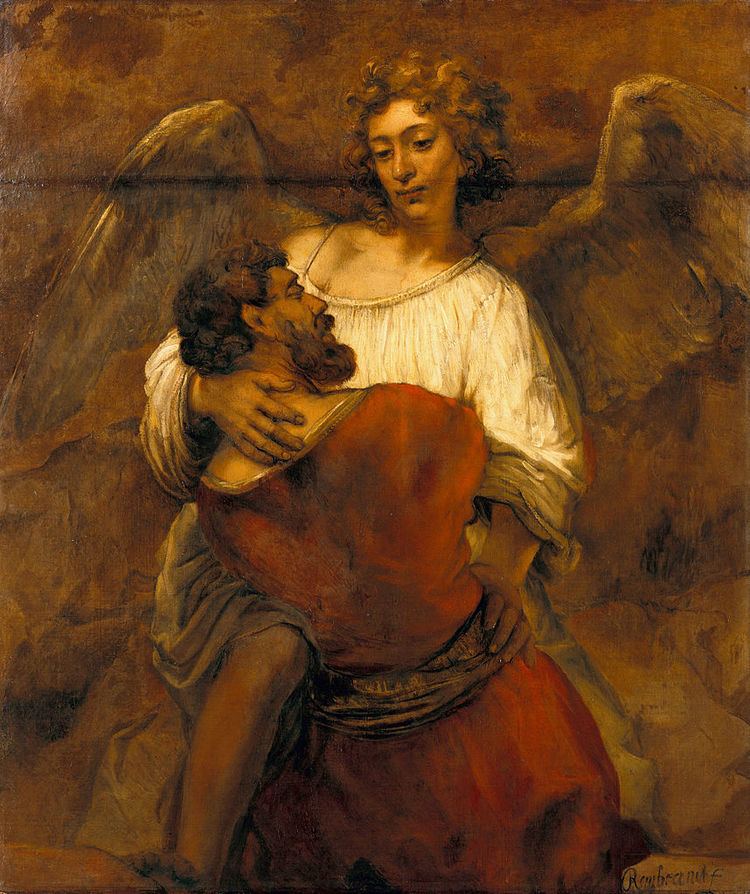 | ||
Similar Vision After the Sermon, The Yellow Christ, Spirit of the Dead Watching, Where Do We Come From? W, Jacob's Dream | ||
The account of Jacob wrestling with the angel is found in Genesis 32:22-32 and referenced elsewhere in Hosea 12:4. The account includes the renaming of Jacob as "Israel", literally "He who struggles with God." The account is also regularly described as Jacob wrestling with God.
Contents
- Biblical text
- Septuagint Talmud and Targums
- Ancient Christian versions
- Interpretations
- Jewish interpretations
- Christian interpretations
- Muslim interpretation
- Other views
- Visual arts
- In music
- In literature and theatre
- References
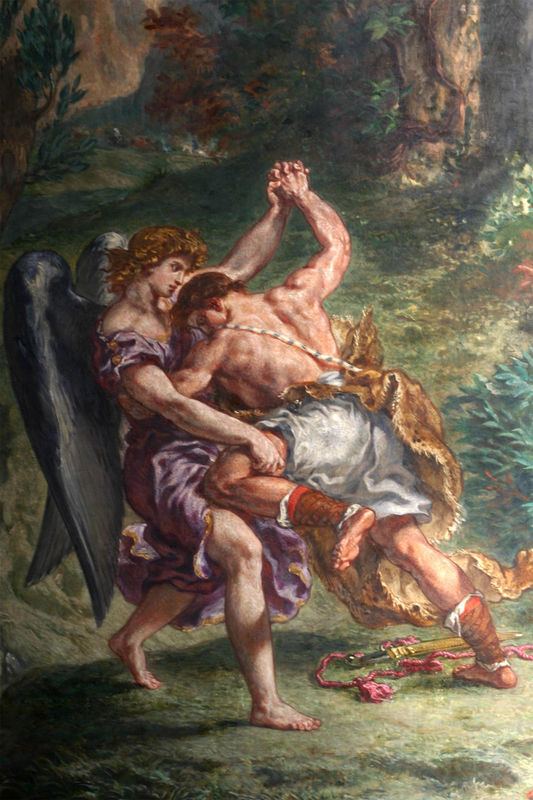
Jacob spent the night alone on a riverside. There, a mysterious being—considered to be an angel or God himself—wrestled with Jacob, even striking him painfully in the hollow of his thigh. Jacob asks the being his name, and while he doesn't receive an answer, he names the place where they wrestled Peniel or Penuel.[Genesis 32:29-30] The event occurs during Jacob's journey back to Canaan.
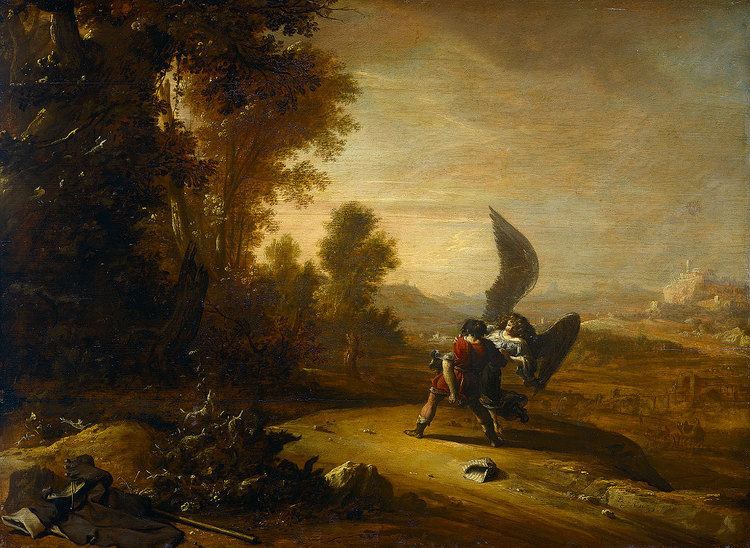
Biblical text
The Masoretic text reads as follows:
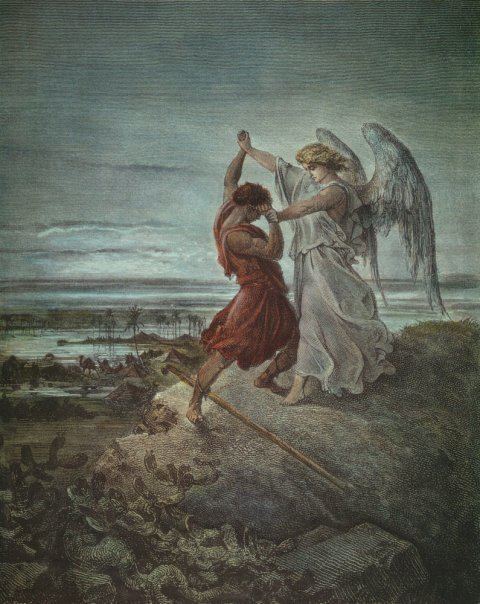
The same night he arose and took his two wives, his two female servants, and his eleven children, and crossed the ford of the Jabbok. He took them and sent them across the stream, and everything else that he had. And Jacob was left alone. And a man wrestled with him until the breaking of the day. When the man saw that he did not prevail against Jacob, he touched his hip socket, and Jacob's hip was put out of joint as he wrestled with him. Then he said, “Let me go, for the day has broken.” But Jacob said, “I will not let you go unless you bless me.” And he said to him, “What is your name?” And he said, “Jacob.” Then he said, “Your name shall no longer be called Jacob, but Israel, for you have striven with God and with men, and have prevailed.” Then Jacob asked him, “Please tell me your name.” But he said, “Why is it that you ask my name?” And there he blessed him. So Jacob called the name of the place Peniel, saying, “For I have seen God face to face, and yet my life has been delivered.” The sun rose upon him as he passed Penuel, limping because of his hip. Therefore to this day the people of Israel do not eat the sinew of the thigh that is on the hip socket, because he touched the socket of Jacob's hip on the sinew of the thigh.
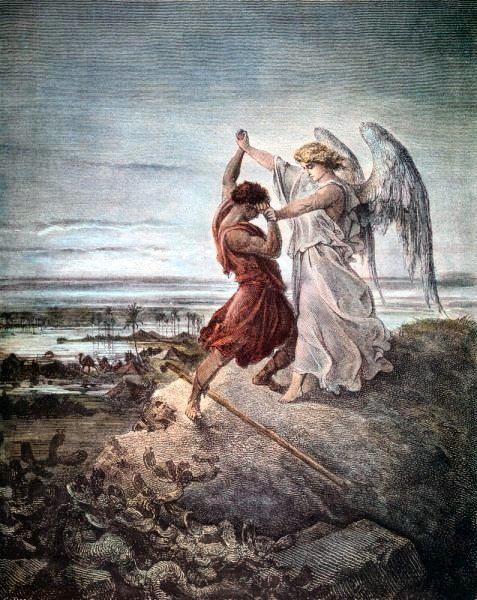
The account contains several plays on the meaning of Hebrew names — Peniel, Israel — as well as similarity to the root of Jacob's name (which sounds like the Hebrew for "heel") and its compound. The limping of Jacob (Ya'aqob), may mirror the name of the river, Jabbok (Yabbok sounds like "crooked" river), and Nahmanides (Deut. 2:10 of Jeshurun) gives the etymology "one who walks crookedly" for the name Jacob.
Septuagint, Talmud and Targums
The Septuagint preserves the Hebrew text both in 32:24 where Jacob wrestles with "a man", and after the man's reply where Jacob calls the place Peniel (Hebrew for Face of God), and has "God" in Gen 32:30 where Jacob says "For I have seen God face to face." Following Hosea 12:4 however the Targum of Onkelos offers "because I have seen the Angel of the Lord face to face", and the Targum of Palestine gives "because I have seen the Angels of the Lord face to face".
Ancient Christian versions
Of the ancient Christian translations the Vulgate follows Hebrew "man" in 32:24 as "man", and Hebrew "face of God" in 32:30 as "face of God". The Syriac Peshitta like Latin and Greek follows the Hebrew with first "man", then "face of God" in Genesis, but then in Hosea 12:4 preserves the Hebrew "angel".
Interpretations
The identity of Jacob's wrestling opponent is a matter of debate, named variously as a dream figure, a prophetic vision, an angel (such as Michael and Samael), a protective river spirit, Jesus or God.
Jewish interpretations
The oldest Jewish interpretation, malakh (angel) is found in Hosea 12:4: "Yes, he had power over the angel, and prevailed: he wept, and made supplication to him: he found him in Bethel, and there he spoke with us;". Though some have questioned whether the Hebrew word malakh may be a later change here. Maimonides believed that the incident was "a vision of prophecy", while Rashi believed Jacob wrestled with the guardian angel of Esau (identified as Samael), his elder twin brother. Zvi Kolitz referred to Jacob wrestling with God.
As a result of the hip injury Jacob suffered while wrestling, Jews are prohibited from eating the meat tendon attached to the hip socket (sciatic tendon), as mentioned in the account at Genesis 32:32.
Christian interpretations
Both Martin Luther and John Calvin believed that Jacob had wrestled with God, although Calvin believed the event was only a vision. Joseph Barker (1854) believed the Bible clearly showed that Jacob wrestled with God. Peter L. Berger also believed Jacob wrestled God.
According to popular author Rosemary Ellen Guiley, "This dramatic scene has spurred much commentary from Judaic, Catholic, and Protestant theologians, biblical scholars, and literary critics. Does Jacob wrestle with God or with an angel?...There is no definitive answer, but the story has been rationalized, romanticized, treated as myth, and treated symbolically."
Among some Christian interpreters, this incident is thought to be a Christophany: J. Douglas MacMillan (1991) suggests that the angel with whom Jacob wrestles is a "pre-incarnation appearance of Christ in the form of a man."
According to one Christian commentary of the Bible incident described, "Jacob said, 'I saw God face to face'. Jacob's remark does not necessarily mean that the 'man' with whom he wrestled is God. Rather, as with other, similar statements, when one saw the 'angel of the Lord,' it was appropriate to claim to have seen the face of God."
Muslim interpretation
Muslim authors have interpreted the incident as Jacob wrestling with God and mention it as one of the ridiculous stories of the Bible.
Other views
Marxist philosopher Ernst Bloch (1968), according to Professor Roland Boer, saw the incident as falling into the category of "myth, or at least legend" and an example of "a bloodthirsty, vengeful God...outdone by cunning human beings keen to avoid his fury".
Whether Jacob was wrestling God or an angel, the story has been described as absurd by psychotherapist and author Gary Greenberg.
The wrestling incident has been compared to the Greek mythology stories of Achilles' duel with Scamander and, more closely, with Menelaus wrestling with Proteus.
Visual arts
One of the oldest visual depictions is in the illustrated manuscript the Vienna Genesis. Many artists have depicted the scene. In sculpture Jacob Wrestling with the Angel is the subject of a 1940 sculpture by Sir Jacob Epstein on display at the Tate Britain. Paintings include:
In music
The Latin text of Genesis 32:30 'Vidi dominum facie ad faciem; et salva facta est anima mea' (I have seen the Lord face to face) was set for the third nocturn at Matins on the second Sunday of Lent and was a popular medieval telling of the story of Jacob's encounter with the angel. It is set as the tenor (upper voice) text of Machaut's multi-text-layered Motet No.15 Vidi dominum (I have seen the LORD) simultaneously with two secular French texts: "Faux semblant m'a decü" and "Amours qui ha le pouvoir." Machaut musically contrasts God's blessing in the Latin text with the disappointments of secular love in the French texts. Charles Wesley's hymn "Come, O Thou Traveller Unknown", often known as "Wrestling Jacob", is based on the passage which describes Jacob wrestling with an angel. It is traditionally sung to the tune of St Petersburg.
In literature and theatre
The motif of "wrestling with the angels" occurs in several novels including Hermann Hesse's Demian (1919), Dodie Smith's I Capture the Castle (1948), Margaret Laurence's "The Stone Angel" (1964). In poetry in poems including Rainer Maria Rilke's "The Man Watching" (c.1920), and Emily Dickinson's poem "A little East of Jordan" (Fr145B, 1860). In theatre, wrestling with the angel is mentioned in Tony Kushner's play Angels in America (1990); the version depicted on-screen was the 1865 version by Alexander Louis Leloir. Gustave Dore's image is reenacted in Jean-Luc Godard's Passion by a film extra dressed as an angel and Jerzy Radziwiłowicz. Also Maud Hart Lovelace's Betsy's Wedding (1955), Stephen King's novel It (1986), Sheila Heti's novel How Should A Person Be? (2012) and David Fennario's play Balconville (1979).
